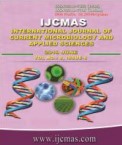


 National Academy of Agricultural Sciences (NAAS)
National Academy of Agricultural Sciences (NAAS)

|
PRINT ISSN : 2319-7692
Online ISSN : 2319-7706 Issues : 12 per year Publisher : Excellent Publishers Email : editorijcmas@gmail.com / submit@ijcmas.com Editor-in-chief: Dr.M.Prakash Index Copernicus ICV 2018: 95.39 NAAS RATING 2020: 5.38 |
Basidiobolomycosis is a very rare form of subcutaneous mycosis often confused with other clinically mimicking conditions. Poor clinical suspicion and lack of experience due to its rarity sometimes misdirects clinicians, pathologists and microbiologists. Wrongful diagnosis may lead to inappropriate and fatal interventions. This present endeavour is aimed at a thorough study of those cases to readdress the challenges in diagnosis and management from eastern India. The study is to create a database of proved cases of basidiobolomycosis from clinically mimicking conditions and to create awareness regarding diagnostic dilemma of these cases. Sixty three clinically suspected cases were included in this study. Among those twenty eight were prospective cases and thirty five were retrospective cases. Relevant histories were taken. Apart from routine hematological, biochemical and radiological investigations, exisional biopsy materials from subcutaneous swelling was examined by direct microscopy with KOH wet mount and fungal culture. Histopatholgical examination was also done. Any fungal growth was identified by growth characteristics and morphological features. Four prospective cases and seven retrospective confirmed cases of subcutaneous basidiobolomycosis were detected from sixty three clinically suspected patients. Out of them eight were found to be culture positive by repeated attempt. In all cases provisional diagnosis could be made by direct KOH microscopy and treatment with oral saturated solution of potassium iodide were initiated with or without positive fungal growth and HPE report. Histopathological sensitivity was low (54.5%). Three clinically and histopathologically suspected cases of rabdomyosarcoma were diagnosed as subcutaneous basidiobolomycosis in this study. Unfortunately one case was lost on follow up. Rest cases were followed up for at least six months post treatment and all showed good response in therapy. A database comprising diagnostic and therapeutic clues has been proposed for these rare subcutaneous mycoses. . With high degree of clinical suspiscion, responsiveness of emperical oral SSKI therapy can be a reliable diagnostic clue.
 |
 |
 |
 |
 |